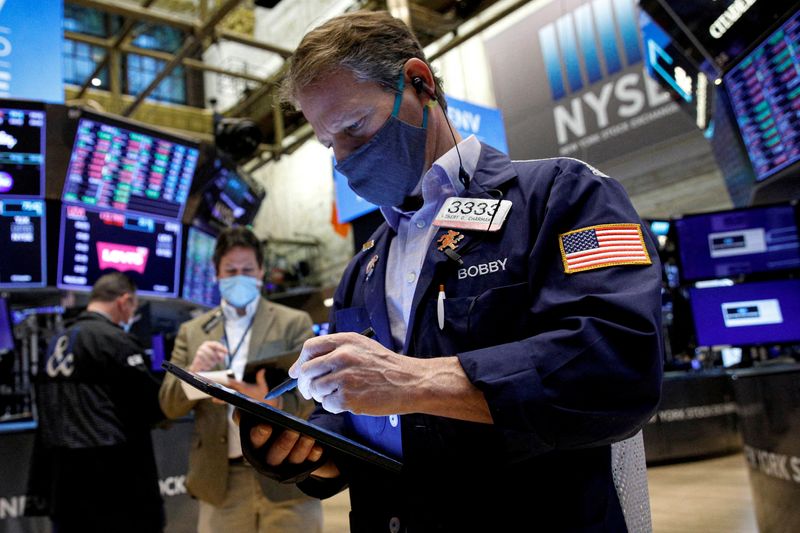By Saqib Iqbal Ahmed
NEW YORK (Reuters) -U.S. stock investors are increasingly turning to the options market for protection against more downside on Wall Street as they worry the Federal Reserve will be less sensitive to equity market volatility as it hikes interest rates to fight inflation.
Demand for puts, typically bought for downside protection, is in line with a trend that has seen investors ramp up hedging in recent months, as the Fed’s hawkish tilt roils markets after years of double digit gains.
The one-month moving average of open puts for each open call on the SPDR S&P 500 ETF Trust (ASX:SPY), stands at 2.25, the most defensive it has been in at least the last four years, data from Trade Alert showed.
Stocks pared losses last month, but the rebound stumbled in April, leaving the S&P 500 down 7% year-to-date. The Cboe Volatility Index, Wall Street's "fear gauge," recently stood at 21 and has spent most of 2022 well above its historic median of 17.6.
"It all goes back to the Fed put... where the Fed does not have the equity market's back right now," said Chris Murphy, co-head of derivative strategy at Susquehanna.
The term "Fed put" how investors describe the market's belief that the central bank will stop tightening or even loosen monetary policy if stocks fall too steeply. One recent example investors often cite is 2019, when the Fed halted its rate hiking cycle after the stock market tumbled.
Some investors believe policymakers are likely to be less reactive to market weakness this time around, however, as the central bank signals it is ready to fight the worst inflation in four decades with jumbo rate hikes and a rapid unwind of its balance sheet.
"High and persistent inflation is turning the Fed from a suppressor of vol and source of returns to a source of vol and suppressor of returns," analysts at BofA Global Research said in a note on Tuesday.
Fund managers in the bank’s most recent survey said they believed the S&P 500 would have to fall to 3637 before the Fed stepped in to support markets – about 13% below this year’s lows. In another sign of nervousness, cash allocations among fund managers stood near their highest since April 2020.
Stock investors could also be nervous about the potential for bond market turbulence to spill over into equity markets, said Anand Omprakash, head of derivatives quantitative strategy at Elevation Securities.
The ICE (NYSE:ICE) BofA MOVE Index, a measure of expected volatility in U.S. Treasuries remains close to the two-year high hit in early March.
More investors also have been taking advantage of any strength in stocks to snap up options hedges. This is a departure from the entrenched trend of "buying the dip," where investors put cash to work by buying more shares whenever the market pulls back.
"Volatility levels are bid because when we do see stocks rebound, when we do see volatility come in, investors are quick to pounce on it," Susquehanna's Murphy said.
The Russell 2000 small-cap index and the S&P 500 retailing exchange-traded fund have drawn defensive options positioning in recent weeks as well, analysts said.

Steven Sears, president of investment adviser Options Solutions, which specializes in options strategies for high net worth individuals, said a murkier outlook for markets combined with sizeable unrealized gains that investors logged last year driving more clients to put on protective trades.
"They are looking to lock those gains without selling," Sears said.